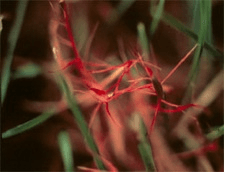Red thread (Laetisaria fusiformis)
This disease is a parasitic form of the mushroom family. Mushrooms grow all year round. These mushrooms feed on obtaining nutrients from the lawn. The disease spreads on the lawn in the form of spores. The spores spread thanks to the wind, air, water and trampling of people.Il Filo Rosso occurs in spring and autumn, during wet periods when temperatures range from 16 ° C to 24 ° C. This disease is particularly felt on turfgrass that grows slowly due to nitrogen deficiency. The varieties most vulnerable to this disease are Poa, Loietto and Agrostide.

HOW TO RECOGNIZE THE RED WIRE
The first noticeable symptoms in the spring are lawn areas soaked in water. Once infected, the leaves will fade to a black-bronze color. Infected leaves mix with healthy leaves giving the lawn a ragged appearance. In humid periods the mushroom develops rapidly on the leaf and on the bottom of the plant. The mushroom produces fillets or areas from coral pink to deep red on the tips of the brown leaves of the grass. The fillets can protrude even two centimeters from the leaf and are easily visible, hence the name "red thread".
HOW TO TREAT THE RED WIRE
The invasion of the Filo Rosso fungus is rapid and the leaves begin to die just two days after becoming infected. This makes the Red Wire difficult to control. The best treatment for this disease is to treat the lawn properly in order to keep it healthy. Some tips to follow are the following:
The first noticeable symptoms in the spring are lawn areas soaked in water. Once infected, the leaves will fade to a black-bronze color. Infected leaves mix with healthy leaves giving the lawn a ragged appearance. In humid periods the mushroom develops rapidly on the leaf and on the bottom of the plant. The mushroom produces fillets or areas from coral pink to deep red on the tips of the brown leaves of the grass. The fillets can protrude even two centimeters from the leaf and are easily visible, hence the name "red thread".
HOW TO TREAT THE RED WIRE
The invasion of the Filo Rosso fungus is rapid and the leaves begin to die just two days after becoming infected. This makes the Red Wire difficult to control. The best treatment for this disease is to treat the lawn properly in order to keep it healthy. Some tips to follow are the following:
- Provide the right amount of nitrogen as nitrogen-deficient lawns are more susceptible to this disease. Slow release granular fertilizers supply the lawn with the right amount of nitrogen for a long period
- Avoid excessive watering and do not water in the late afternoon or evening. Leaving the lawn wet at night will cause the spores of the disease to spread rapidly creating more damage.
- Reduce the shaded areas that form more moisture on the lawn.
- Make sure the soil has good drainage. This causes the humidity to remain trapped on the surface of the lawn thus promoting the spread of the disease spores. Regular airing of the helps to unpack the soil and reduces the problem of moisture in the lawn. The aeration also improves the absorption of water and the circulation of air in the root area.
